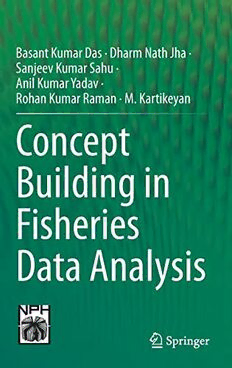
Concept Building in Fisheries Data Analysis PDF
Preview Concept Building in Fisheries Data Analysis
Basant Kumar Das · Dharm Nath Jha · Sanjeev Kumar Sahu · Anil Kumar Yadav · Rohan Kumar Raman · M. Kartikeyan Concept Building in Fisheries Data Analysis Concept Building in Fisheries Data Analysis (cid:129) (cid:129) Basant Kumar Das Dharm Nath Jha (cid:129) (cid:129) Sanjeev Kumar Sahu Anil Kumar Yadav (cid:129) Rohan Kumar Raman M. Kartikeyan Concept Building in Fisheries Data Analysis BasantKumarDas DharmNathJha ICAR PrayagrajRegionalCentre CentralInlandFisheriesResearch ICAR-CIFRI Institute Prayagraj,UttarPradesh,India Barrackpore,WestBengal,India SanjeevKumarSahu AnilKumarYadav FisheriesResourceAssessment GuwahatiRegionalCentre &Informatics ICAR-CIFRI ICAR-CIFRI Gowahati,Assam,India Barrackpore,WestBengal,India RohanKumarRaman M.Kartikeyan DivisionofSocioEconomics BengaluruRegionalCentre &Extension ICAR-CIFRI ICARResearchComplex Bangalore,Karnataka,India forEasternRegion Patna,Bihar,India ISBN978-981-19-4410-9 ISBN978-981-19-4411-6 (eBook) https://doi.org/10.1007/978-981-19-4411-6 Thisworkisaco-publicationwithNarendraPublishingHouse,NewDelhi.Thisworkislicensedfor electronicsaleinallcountries.TheworkislicensedforprintsaleinallcountriesexceptIndia.Soldand distributedinprintinIndiabyNarendraPublishingHouseC-21,VarunApartment,Sector-9,Rohini, DELHI–110085,India JointlypublishedwithNarendraPublishingHouse ISBNoftheNarendraPublishingHouseedition:9789390611676 #NarendraPublishingHouse2023 Thisworkissubjecttocopyright.AllrightsaresolelyandexclusivelylicensedbythePublisher,whether thewholeorpartofthematerialisconcerned,specificallytherightsoftranslation,reprinting,reuseof illustrations, recitation, broadcasting, reproduction on microfilms or in any other physical way, and transmission or information storage and retrieval, electronic adaptation, computer software, or by similarordissimilarmethodologynowknownorhereafterdeveloped. Theuseofgeneraldescriptivenames,registerednames,trademarks,servicemarks,etc.inthispublication doesnotimply,evenintheabsenceofaspecificstatement,thatsuchnamesareexemptfromtherelevant protectivelawsandregulationsandthereforefreeforgeneraluse. The publisher, the authors, and the editorsare safeto assume that the adviceand informationin this bookarebelievedtobetrueandaccurateatthedateofpublication.Neitherthepublishernortheauthorsor theeditorsgiveawarranty,expressedorimplied,withrespecttothematerialcontainedhereinorforany errorsoromissionsthatmayhavebeenmade.Thepublisherremainsneutralwithregardtojurisdictional claimsinpublishedmapsandinstitutionalaffiliations. ThisSpringerimprintispublishedbytheregisteredcompanySpringerNatureSingaporePteLtd. The registered company address is: 152 Beach Road, #21-01/04 Gateway East, Singapore 189721, Singapore Foreword India has emerged as one of the largest producers of fish in the world with a total productionof13.76mmt,contributing7.58%toglobalproduction.Ofthetotalfish production,over70%comesfromtheInlandsector.TheInlandfisheriesresources arevastintheformofrivers,canals,floodplainlakes,ponds,reservoirsandbrackish water bodies. These resources are bestowed with wide varieties of fish species, which are distributed based on their physiological and climatic requirements. The fisheries sector and its spin-off activities provide livelihood opportunities to a diverse group of rural artisans. Mapping of the resources, fish distribution pattern, associated fishing communities, methods of fishing, income generating opportunities, trade, etc. has led tothegeneration ofa colossal volumeof data. To analyseandinterpretthisdata,thereisaneedtohavevariousdataanalysistools. I am very happy that the ICAR-Central Inland Fisheries Research Institute, Barrackpore, is publishing the book entitled Concept Building in Fisheries Data Analysis.Thebookbuildsupaconceptualfoundationoffrequentlyusedstatistical data analysis tools, covering both theoretical and practical approaches and its analysis with various standard software packages. The most important part of the book is data interpretation from the analysis output, which, in my opinion, will be veryhelpfultothepractitionersinvolvedinfisheries.Iampleasedwiththestructural designofthebook,especiallythewayithasdemonstratedthestatisticalmethodsby using real-life fisheries data. I sincerely believe that this book will help students, practitionersandteachersassociatedwithinlandfisheriesandguidethemtoperform fundamentalstatisticalanalysesalongwithmeaningfulinterpretationofresults. vv vi Foreword Icomplimenttheauthorsfortheirstupendouseffortsinbringingoutthisbook—a veritabletreatiseonboththeoreticalandpracticalconceptsofstatisticsinoneplace.I wishthemalltheverybestfortheirfutureendeavours. IndianCouncilofAgriculturalResearch T.Mohapatra NewDelhi,India Foreword Fisheries professionals—most notably, students and researchers—invariably pro- vokearesponsetostatisticaldataanalysisas‘StatisticswastheworstsubjectIliked in my student life’. This negative attitude towards statistics consequently makes them fumble in real-life fisheries data analysis. I do know the reason that most of themcannotaffordtofulfil:theneedtobecompetentinstatistics.Ibelieveagood bookcanhelptocomeoutfromthisdogma,andcompetencycanbeacquired,asfar as basic data analysis is concerned. Unfortunately, statistics books exclusively dealingwithfisheriesdataanalysisarerare—especiallyinIndia. I am overwhelmed by reading this book entitled Concept Building in Fisheries Data Analysis brought out by the group of statisticians at ICAR-Central Inland Fisheries Research Institute, Barrackpore. The book is well structured, starting from field data collection methods, analysis and to the interpretation of results. Though the mathematical formulas are imperative in statistics, this book has emphasized bringing clarity in concept, which will build a strong base in statistics for students. Books on data analysis are undeniably plentiful, but they describe statistics in general. But,this book isunique because of itsexclusivefisheriesdata analysisandsubsequentinterpretationthereof.Thedatapresentationdescribedinthe book is impressive. The authors make the readers feel that statistics is away from mathematicalcomplexitiesandcouldbeeasytounderstand,appealingandinterest- ing. The strongest part of the book is presentation of examples, which are taken exclusively from field-based fisheries interventions with their post-analysis interpretations. The exercise provided in each chapter will be highly useful for students. Demonstration software—Excel and R—introduced in the book is the prudent choice. Fisheries professionals feel at home in excel while R is open- source,incurringpracticallynocost. vviiii viii Foreword Theauthorsindeeddeserveappreciationforbringingoutthisbook.Iwishthem allthesuccessoftheirendeavourandwillbelookingforwardtoreadingmoresuch booksbytheauthors. AssamFisheriesDevelopmentCorporation DilipKumar Guwahati,India NationalPlatformforSmallScale FishWorkers(NPSSFW) Kolkata,India BoardofGovernors, InstituteofLivelihoodResearch andTraining(ILRT) Hyderabad,India ICAR-CIFE Mumbai,India InternationalCivilService(FAOofUN) NewYork,NY,USA Preface Effective management strategies of inland fisheries demand efficient quantitative dataanalysisandsubsequentinterpretationofresults.Thecontributionofstatisticsis imperativewhereverdataissubjecttouncertaintywhichisfrequentlyencounteredin generatinginlandfisheriesdata.Thereby,estimation,interpretationandpredictionof fishery resources that lead to formulating government policy or any other related issue,andtheroleofstatisticscomesin. Thusitisnecessarythatanupdatedandimprovedunderstandingofthestatistical concepts is essential for students, researchers, planners, decision-makers and officials associated with inland fisheries. With this in mind, a first attempt was made in 2018, to provide training supported by a training manual to help the researchers associated with inland fisheries. With the success and suggestions receivedfromtheparticipantsoffirsttraining,animprovisedmanualwasprepared during the second training programme held in 2019. Based on the feedback of the trainees, the authors conceived the idea of publishing a book. The book design emphasizesonbuildingthefoundationonthestatisticalconceptsothatreaderscan easily understand and execute fundamental statistical analyses themselves. It has boththeoreticalconceptandpracticalimplementationofthattheory.Thetheoretical part aims at building and explaining concepts whereas the practical sessions focus primarily on a disciplined way of data entry followed by analyses by software. Specialemphasishasbeengivenondatainterpretation. Itisverychallengingtobuildupkeyconceptsofstatisticswithoutamathematical background.Detailedmathematicalderivationofthemethods—especiallyformul- tivariateanalysis—hasbeenavoidedpurposefullybecauseofthetargetedaudience who are mainly the users of statistics. Therefore, the authors have provided an essential reference list for advanced users. Utmost care has been taken to demon- strate thestatistical methodsbyusingreal-life fisheries data.Theauthorshopethat this book will be helpful to perform frequently used statistical analyses and to interpret the results in a meaningful way. Although sophisticated analyses are ix x Preface appealing,thenecessaryfoundationinstatisticsisessentialtoproceedtowardshigh- levelanalysis.Theauthorshopethatthisbookisanessentialstepinthatdirection. Barrackpore,WestBengal,India BasantKumarDas Prayagraj,UttarPradesh,India DharmNathJha Barrackpore,WestBengal,India SanjeevKumarSahu Gowahati,Assam,India AnilKumarYadav Patna,Bihar,India RohanKumarRaman Bangalore,Karnataka,India M.Kartikeyan
